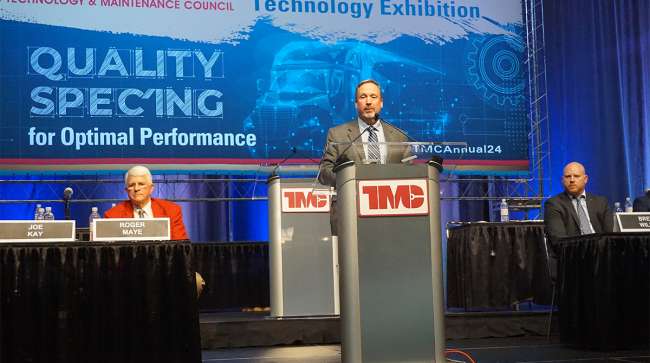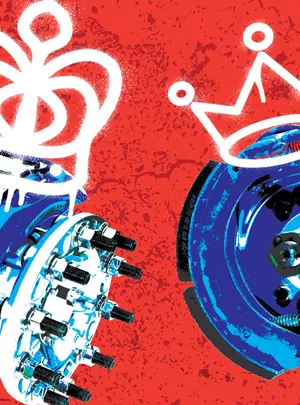Features Editor
Are Air Disc Brakes Worth It?

[Find the latest in equipment & maintenance: Explore this quarter's issue of Calibrate]
In choosing brake systems for a commercial fleet, there’s no wrong answer whether air disc brakes are a right fit versus drum brakes. There are plenty of advantages for both; drum brakes are traditionally low maintenance, durable and inexpensive to manufacture, while disc brakes provide better stopping distances, more consistent braking and less brake fade.
Although drum brakes are an OEM standard, air disc brake systems are becoming a more reasonable choice for maintenance leaders. Yet still, it’s critical to properly spec for application, said Roger Maye, national service manager at ConMet, adding that the modern brake systems are not a one-size-fits-all system.
“Do your homework. Weigh your options and do what works best for your fleet,” he said. “Results will vary based on the specifics of your fleet.” Maye added that regardless of drum or air disc brake system, brake performance has never been better, and both perform to a higher standard with a good fleet inspection and maintenance program.
Maye, along with other industry experts, described the difference between both brake systems during a session at the Technology & Maintenance Council Annual Meeting in New Orleans in March.
Joe Kay, chief engineer for braking systems at Cummins-Meritor, noted that drum brakes have a long history in North America and are popular in most OEM medium- and heavy-duty models. He said that drum brakes continue to be a global product.
“Drum brakes are beneficial in the more abrasive and heavy-duty environments,” Kay said, adding that vehicles used in construction and industrial areas worldwide have proved to be more applicable to drum brakes.
“The drum brake has a little bit better resistance to wearing those pads [while in the dirt],” he explained, noting that with drum brakes, the few parts it’s composed of make it easy for serviceability, and complete rebuilds can be done by entry-level technicians.
More Q3 Calibrate

►Are Air Disc Brakes Worth It?
►Freeze: Let's Get Optimistic
►Hexagon Agility and Brudeli Green Mobility to Deliver NZEVs
►5 Questions With Kenneth M. Eggen
►ROTATE Recap: Know the 'What' and 'Why' of Data
►TMC Corner: Industry Groups Updating ADAS Adoption Information
Explore the Issue!
He also pointed out that the overall brake performance is good and exceeds FMVSS121 reduced-stopping-distance requirements.
The requirement, implemented by the National Highway Traffic Safety Administration in 2011, is intended to reduce fatalities and injuries associated with crashes involving tractors and trailers.
“Truck manufacturers met this rule by increasing the size of the drum brakes on steer axles by using disc brakes,” Maye explained.
But with its advantages, Kay singled out a glaring challenge with drum brakes: inspection violation. During its Brake Safety Week last August, the Commercial Vehicle Safety Alliance conducted Level I inspection of more than 18,000 vehicles and trailers. Of those, more than a third were equipped with drum brakes. However, drum brakes accounted for most violations.
“Contamination was a big violation,” Kay said, noting that cracks and voids along with loose and worn rotors were other major violations.
With air disc brakes, Mark Holley, director of marketing and customer solutions wheel end for Bendix, noted, fleets likely will see reductions in CVSA violations.
“The main thing is that in these safety measures, they’re looking for brakes out of adjustment,” Holley explained. “It’s very easy to see that on a drum brake. But in an air disc brakes, the adjustment mechanism is internal to the brake. So it really is there’s nothing for the inspector to see.”
In addition, Holley noted that air disc brakes enjoy the advantage of fade resistance in which there is virtually no brake fade and no degradation in stopping power leading to shorter stopping distances. He also said that it provides driver safety, especially during mountain descents. Holley pointed out the advantages of total cost of ownership and lower maintenance costs.
“It’s really one of the most important considerations,” he said. “With drum brakes, the initial cost is lower, but you have to look at the total life cycle of your equipment. What are the total costs? With air disc brakes, once you get to that second or third year — for most applications, not all — you’ll see the difference in total cost of ownership.”

Holley
Holley touted the improved braking performance and its relation to driver satisfaction and retention.
“What we hear is that the side-by-side control and the stopping distance is what the driver needs,” he said.
However, Holley noted that there are some challenges concerning air disc brakes such as higher acquisition and repair costs, tone ring corrosion and subpar performance in abrasive environments, as well as technician training and knowledge.
“This may be more of the trailer technician side because there aren’t many ADBs on trailers, but we need to step up in the industry and do a better job on training,” he said. “You can reach out to the suppliers. There is online training and educational videos to help technicians.”
Holley said the future is bright for air disc brake adoption, although trailer and medium-duty conversion lags but continues to increase. He noted that the emergence of electric vehicles and other technology drivers could prove helpful.
“Drag reduction, brake pad wear and temperature sensing … we are seeing a lot more interest in this,” Holley said about the benefits of EV implementation. “With lighter-weighted brakes and rotors, that will save your technicians a lot of time.”
To provide the fleet perspective, Brent Hilton, director of maintenance with Maverick Transportation, said his fleet has specified ADB on its trucks since 2019 and trailers since 2008. For its pad-wear projections, Hilton said his team expected anywhere from 600,000 to 1 million miles. However, the actual results “wasn’t even close,” he said, adding that the most tractors reached pad-replacement mileage bands of 200,000 to 300,000 miles.
Want more news? Listen to today's daily briefing above or go here for more info
He cautioned fleets to heed supply chain conditions and keep an eye on downtime and labor costs.
“Availability is something you have to watch out for concerning the supply chain,” he said. “Also, repair time… some of these failures can be real costly, real quick.
“Make sure you’re doing the preventive maintenance timely and make sure you’re doing repairs that your service provider has trained you to do, and is based off your application.”
Maverick Transportation ranks No. 76 on the Transport Topics Top 100 largest for-hire carriers in North America.




